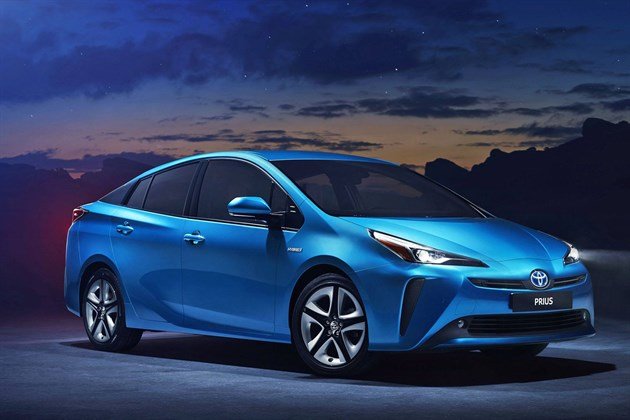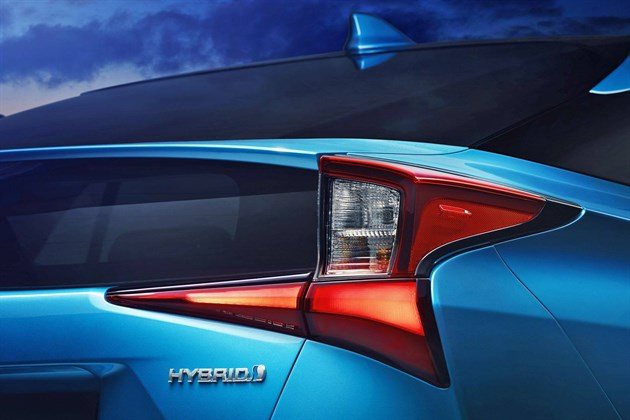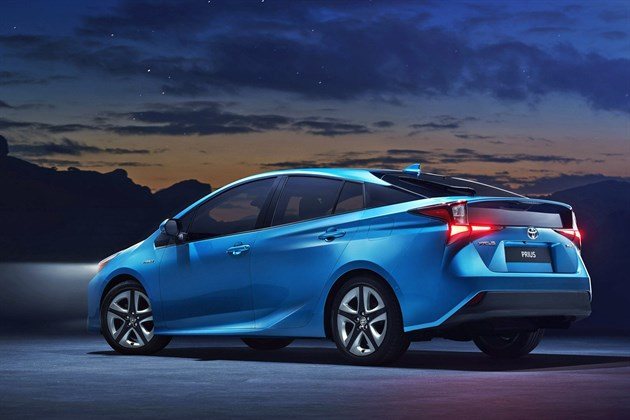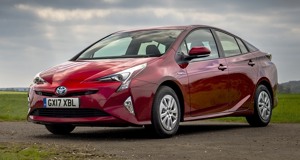Toyota Prius (2016 – 2022) Review
Toyota Prius (2016 – 2022) At A Glance
The Toyota Prius had been refined to the point of brilliance when this generation was launched in 2016. Brilliant, that is, if you want a low-emissions, easy-to-live-with hatch that’s as undemanding to drive as it is on your monthly budget. Don’t expect fireworks, but it gives the Audi A3 e-tron and innovative Hyundai Ioniq a lot to contend with as a used buy. Read on for our full Toyota Prius review.
This generation of the Toyota Prius offers impressive fuel economy, extremely relaxed driving dynamics, good build quality and a very comfortable cabin.
If you want to glide around effortlessly without using too much fuel, there are few better ways to go about it.
It sits on Toyota's TNGA (Toyota New Global Architecture) platform, which provides a sound combination of ride, handling and steering that is much improved over previous versions.
Toyota opted to use the same hybrid system as before, but it was revised and reworked.
The updated engine is paired with aerodynamic styling, providing an official economy figure of 94.1mpg and CO2 emissions of just 70g/km, despite this being a traditional hybrid rather than a plug-in – the Toyota Prius Plug-in was added to the range in 2017.
There was also a facelift in 2019, which added a smoother look to the front end.
The radical exterior looks are mirrored in the cabin, which has a futuristic layout with a large, easy-to-use touchscreen system as standard.
Space is generous in the front and the back row has plenty of legroom, but the aerodynamic roofline hampers headroom for taller passengers. The boot is spacious with a capacity of 343 litres.
On the road, the Toyota Prius is easy to drive thanks to its CVT automatic transmission. At slow speeds, the car runs in near silence and will often operate on electric power alone, making it serene around town.
Even at higher speeds, it’s quiet and refined, plus it has safe, predictable handling and light controls.
Standard equipment includes alloy wheels, auto lights, auto wipers, road sign assist, a reversing camera, lane departure warning and adaptive cruise control – so even used buyers of the basic model won’t be left wanting.
Upper trim levels gain luxuries like wireless phone charging and automatic parking.
There are some newer rivals to consider including the Hyundai Ioniq, which is available as a pure EV, a plug-in or a traditional hybrid, the latter of which undercut the Toyota Prius on price when new.
However, it’s safe to say that the Toyota Prius is an excellent choice for those who want to flaunt their eco-friendliness and travel around in a bubble of serenity.
Fancy a second opinion? Read heycar’s Toyota Prius review.
Toyota Prius (2016 – 2022) handling and engines
- Readers report Real MPG to be between 48–80 mpg
Toyota Prius (2016 – 2022): Handling and ride quality
The Toyota Prius is impressive out of town.
Improved refinement makes motorway driving more pleasant, plus the ride quality is reasonable even on uneven country roads, although it can get a little wobbly when the surface is particularly bad.
Through bends the Toyota Prius is predictable and the steering, while on the light side, is accurate enough to inspire confidence.
A BMW i3 is more enjoyable to drive in its range-extender form, while an Audi A3 e-tron imparts a greater sense of refinement and solidity on the road.
Toyota Prius (2016 – 2022): Engines
The basic powertrain from the previous Toyota Prius was retained for the 2016 generation, but with various changes to improve its economy.
A 1.8-litre four-cylinder petrol engine lives under the bonnet, while under the floor is a smaller, lighter battery pack than that used in the old car, linked to an electric motor.
The engine produces 98PS and 142Nm of torque, while the electric motor has outputs of 72PS and 163Nm.
Logically that suggests the Toyota Prius has peak power of 170PS, but it’s not that simple, since the engine and electric motor don’t produce peak power at the same time. Overall peak system power for the car is actually 122PS.
From a standstill, the Toyota Prius accelerates swiftly and seamlessly, although it can get a little loud due to the CVT automatic gearbox.
This is only a problem when accelerating hard though – and it’s far quieter than the previous Toyota Prius.
For town driving the car is great, making light work of stop-start traffic.
Toyota Prius (2016 – 2022): Safety
This version of the Toyota Prius was awarded five stars by Euro NCAP when it was crash tested.
Helping it achieve this top score was the inclusion of an automatic emergency braking package, which Toyota calls Safety Sense.
This Toyota Prius also has lane departure warning and assist to keep you in the right lane.
Automatic high beam assistance, traffic sign recognition, blind spot monitoring, rear cross traffic alert are fitted to all but the base trim, while Isofix child seat mounts in the rear and a full complement of airbags come with every model.
Toyota Prius (2016 – 2022): Towing
Whether you are towing a braked or unbraked trailer, this Toyota Prius has a maximum capacity of 725kg.
| Engine | MPG | 0-62 | CO2 |
|---|---|---|---|
| Hybrid | 79–83 mpg | 10.6 s | 70–85 g/km |
Real MPG average for the Toyota Prius (2016 – 2022)

Real MPG was created following thousands of readers telling us that their cars could not match the official figures.
Real MPG gives real world data from drivers like you to show how much fuel a vehicle really uses.
Average performance
81%
Real MPG
48–80 mpg
MPGs submitted
300
Toyota Prius (2016 – 2022) interior
- Euro NCAP rating of five stars
| Dimensions | |
|---|---|
| Length | 4540 mm |
| Width | 1760 mm |
| Height | 1470 mm |
| Wheelbase | 2700 mm |
Toyota Prius (2016 – 2022): Practicality
The Toyota Prius offers a decent amount of space for passengers and luggage.
The front seats are comfortable and there is plenty of adjustment, while the back row provides decent legroom and, for most passengers, enough headroom, although the aerodynamic roof means taller occupants might struggle a little.
The outer two rear seats have Isofix mounting points.
The boot is nice and low, but it has a fairly large load lip and it narrows between the rear wheels.
That said, it is still very spacious and practical – capacity to the load cover is 343 litres, or 502 litres to the roof.
This can be expanded even further by folding the rear seats flat, freeing up 1558 litres.
Toyota Prius (2016 – 2022): Quality and finish
The interior of the Toyota Prius is light and airy, and feels futuristic, with a swooping dashboard layout and lots of glossy plastics.
There are a few elements that look a little cheap, but everything seems sturdy and built to last.
Toyota Prius (2016 – 2022): Infotainment
The Toyota Prius comes with a large colour seven-inch touchscreen system on all variants, which controls audio and connectivity. It also incorporates a reversing camera as standard.
Also standard across the range are DAB radio, USB connectivity, Bluetooth, auto lights and keyless entry and a start button.
Toyota Prius (2016 – 2022) value for money
Toyota Prius (2016 – 2022): Prices
You will need a budget of £14,000 to bag a good used Toyota Prius that’s eight years old and with 70,000 miles on the clock. This gets you a well specced Business Edition model.
For a three-year-old Toyota Prius with 30,000 miles, you will need to increase your spend to £21,000.
Toyota Prius (2016 – 2022): Running Costs
It was originally claimed that the Toyota Prius was good for combined fuel economy of 94.1mpg, but that was revised down to a more realistic 83.1mpg for the base model and 78.5mpg for those on larger alloy wheels.
All of these figures assume you can make the most of the EV driving mode. More likely is the mid-60s economy we see from our Real MPG data, which is still very good for a family car.
With carbon dioxide emissions ranging from 70g/km to 85g/km with this generation of Toyota Prius, it means early models qualify for free road tax.
Those registered from 1 April 2017 onwards require the standard rate of £180 per year for 12 months’ Vehicle Excise Duty.
On top of Toyota’s standard warranty cover, you can extend this by 12 months and 10,000 miles by having the car serviced at a Toyota dealer. This can then last up to 10 years and 100,000 miles.
The Toyota Prius has proven to be very reliable, so you should only spend on routine maintenance. As for insurance, it sits in group 14, so none will be very expensive when it comes to paying your premium.
Satisfaction Index
 What is your car like to live with?
What is your car like to live with?
We need your help with our latest Satisfaction Index, so that we can help others make a smarter car buying decision. What's it like to live with your car? Love it? Loath it? We want to know. Let us know about your car - it will only take a few minutes and you could be helping thousands of others.
Help us with the Honest John Satisfaction Index nowToyota Prius (2016 – 2022) models and specs
The Toyota Prius Active models get 15-inch alloy wheels, dual-zone automatic air- conditioning, smart entry for the driver’s door and push-button start.
There are also LED headlights, Toyota Touch 2, DAB radio, electrically adjustable driver’s seat, driver’s seat lumbar adjust and dual 4.2-inch colour TFT multi-information displays. Forward Collision Warning with Autonomous Emergency Braking, Adaptive Cruise Control, Road Sign Assist, Lane Departure Alert and Automatic High Beam are standard.
A Toyota Prius Business Edition adds soft-touch cabin trim, wireless phone charger, smart Entry on all doors and boot, colour head-up display, Blind Spot Monitor, Rear Cross Traffic Alert, heated front seats, a leather steering wheel trim and an auto-dimming rear-view mirror.
The Toyota Prius Business Edition Plus offers 17-inch alloy wheels, Toyota Touch 2 with Go satellite navigation and connectivity functions, Simple Intelligent Park Assist plus front and rear parking sensors.
The Toyota Prius Excel is additionally equipped with leather upholstery, a JBL premium audio system, rain-sensing wipers and Toyota 2 with Go Plus (satellite navigation and connectivity with added functions).
| Dimensions | |
|---|---|
| Length | 4540 mm |
| Width | 1760 mm |
| Height | 1470 mm |
| Wheelbase | 2700 mm |
| Miscellaneous | |
|---|---|
| Kerb Weight | 1375–1450 kg |
| Boot Space | - |
| Warranty | 5 years / 100000 miles |
| Servicing | 10000 miles |
| Costs | |
|---|---|
| List Price | £24,995–£29,540 |
| Insurance Groups | 14 |
| Road Tax Bands | A |
| Official MPG | 78.5–83.1 mpg |
| Euro NCAP Safety Ratings | |
|---|---|
| Adult | - |
| Child | - |
| Pedestrian | - |
| Overall | 5 |
On sale until March 2023
| Hatchback | |||
|---|---|---|---|
| Version | List Price | MPG | 0-62 |
| Entry VVT-i Auto 5dr | - | - | - |
On sale until November 2022
| Hatchback | |||
|---|---|---|---|
| Version | List Price | MPG | 0-62 |
| 1.8 Hsd Active Nav CVT 5dr | £24,995 | 83.1 mpg | 10.6 s |
| 1.8 Hsd Business Edition Nav CVT 5dr | £25,935 | 83.1 mpg | 10.6 s |
| 1.8 Hsd Business Edition Plus CVT 5dr | £26,985 | 78.5 mpg | 10.6 s |
| 1.8 Hsd Excel CVT 5dr | £28,350 | 78.5 mpg | 10.6 s |
| 1.8 Hybrid Business Edition CVT 17IN AWD 5dr | £29,540 | - | - |
| 1.8 Hybrid Business Edition Plus CVT AWD 5dr | £27,550 | - | - |
Model History
- September 2015: New Toyota Prius revealed
- November 2015: Toyota Prius opens for UK ordering
- March 2016: Plug-in Prius launched
- February 2017: Toyota substantially reduced prices of the Prius Plug-in
- February 2018: Updates to Toyota Prius for 2018:
- November 2018: Hybrid AWD-i launched in Toyota Prius at Los Angles Auto Show.
- May 3019
September 2015
New Toyota Prius revealed
The new Prius retains the established 1.8-litre VVT-i petrol engine featured in the current model, but changes to the unit have taken its thermal efficiency to a world-leading 40 per cent, a figure comparable to a diesel engine.
The auxiliary batteries have been moved from the boot to the engine compartment and the relocation of the hybrid battery beneath the rear seats (see below) also helps free up more luggage space. Boot volume has increased to 502 litres in the new Prius.
The new Prius features a new nickel-metal hydride (NiMH) hybrid battery, considered by Toyota to be the optimum choice to meet market requirements. The battery has been relocated beneath the rear seat, avoiding any intrusion in boot space.
Toyota says it has improved the look and performance of the multi-information display in the driver’s instrument binnacle. Data and images are now presented in full colour with high resolution graphics on a dual, 4.2-inch display. The right-hand section presents speed, fuel level and other basic data and left section is a multi-display where the driver can select preferred content using a switch on the steering wheel.
There is also a new colour head-up display, which projects essential vehicle data and alerts on to the lower section of the windscreen, making information instantly and easily readable without the driver having to taking their eyes off the road ahead.
November 2015
Toyota Prius opens for UK ordering
Priced from £23,295, all Prius models get LED headlights with Automatic High Beam, electric driver’s seat adjustment, Smart Entry with push-button start and the Toyota Touch 2 multimedia system with touchscreen control and DAB radio reception. An enhanced Toyota Safety Sense package is also standard, as detailed below.
A new dual-zone air conditioning system is also standard, equipped with a function that detects whether the front passenger seat is occupied and automatically adjusts air vent opening and air flow accordingly, for more efficient and energy-saving operation.
The new Prius is available in seven exterior colours, including Hypersonic Red, a new pearlescent shade that offers extra depth and reflective qualities. The interior is available in Cool Grey or Black, with matching trim and cloth upholstery. Leather seats (Excel grade) are in Cool Grey with black shoulder sections, or Black with contrast blue stitching.
A number of option packs are available for new Prius to add style, protect the cabin and bodywork and provide extra in-car entertainment.
The Parking Pack (£350, Active and Business Edition) equips the car with front and rear parking sensors, while the Protection Pack (£300, all versions), adds front and rear mudflaps, scuff plates, a rear bumper protection plate and a boot liner.
| MODEL | OTR PRICE |
| Prius Active | £23,295 |
| Prius Business Edition | £24,195 |
| Prius Business Edition Plus | £25,995 |
| Prius Excel | £27,450 |
| ENGINE | |
| Type | 4-cylinder in-line, DOHC |
| Displacement (cc) | 1,797 |
| Max. output (PS/kW @ rpm) | 98/72kW @ 5,200 |
| Max. torque (Nm @ rpm) | 142 @ 3,600 |
| ELECTRIC MOTOR | |
| Max. output (PS/kW) | 72 /53 |
| Hybrid battery material | Nickel-metal hydride (NiMH) |
| HYBRID SYSTEM | |
| Combined system max. output (PS/kW) | 122/90 |
| PERFORMANCE | |
| Acceleration 0 – 60mph | 10.3 sec |
| Acceleration 50 – 75mph (80 – 120 km/h) | 8.3 sec |
| Max. speed (mph) | 120 |
| FUEL CONSUMPTION & EMISSIONS (subject to final homologation) | |
| Fuel consumption – combined cycle (mpg) | From 94.2 |
| CO 2 emissions – combined cycle (g/km) | From 70 |
| DIMENSIONS | |
| Length (mm) | 4,540 |
| Width (mm) | 1,760 |
| Height (mm) | 1,470 |
| Wheelbase (mm) | 2,700 |
| Interior length (mm) | 2,110 |
| Interior width (mm) | 1,490 |
| Interior height (mm) | 1,195 |
| Towing capacity – unbraked (kg) | 725 |
March 2016
Plug-in Prius launched
Claimed figures of of 282.5mpg and CO2 emissions of 22g/km, and an EV range of more than 30 miles/
Large-capacity lithium-ion battery, located beneath the loadspace, is key to Prius Plug-in’s 30-mile-plus EV range. Volume has been increased from 87 to 145 litres and energy capacity doubled from 4.4 to 8.8kW/h, yet at 120kg it is only 50% heavier than the none plug in battery.
EV power has been increased by 83 per cent, thanks to the development of a Dual Motor Drive System. A new, highly compact clutch within the transaxle allows the hybrid system generator to act as a second electric motor. This boosts EV driving power to 68kW, giving better acceleration and even more engaging performance, while at the same reducing the frequency with which the petrol hybrid engine is brought into play.
February 2017
Toyota substantially reduced prices of the Prius Plug-in
The revised prices shown are after the Government grant of £2,500.
Toyota Prius Plug-in Business Edition Plus: £29,195
Toyota Prius Plug-in Business Edition Plus with Solar Roof Panel: £30,695
Toyota Prius Plug-in Excel: £31,395
February 2018
Updates to Toyota Prius for 2018:
There are some equipment changes for the 2018 Prius, the latest generation of Toyota’s pathfinding hybrid electric car. Automatic wipers have been made a standard feature on all versions apart from Active grade, and all new Prius now come with a leather-trimmed steering wheel. Active and Business Edition have a new-style 15-inch alloy wheel, which can also be specified as an option for Business Edition Plus and Excel grade models in place of the 17-inch wheels. Finally, Autumn Silver has been added to Prius’s colour palette.
The new fuel consumption and emissions figures are shown below.
| Prius with 15in wheels | Prius with 17in wheels | ||
| Fuel consumption (mpg) | Combined | 83.1 | 78.5 |
| Urban | 80.7 | 76.3 | |
| Extra-urban | 85.6 | 80.7 | |
| CO 2 emissions – combined cycle (g/km) | 78 | 82 | |

November 2018
Hybrid AWD-i launched in Toyota Prius at Los Angles Auto Show.
Hybrid AWD-i, a new, intelligent, electric all-wheel drive system that provides more sure-footed handling and peace-of-mind driving. The system uses an additional high-torque electric motor to provide extra drive through the rear axle when required. It is engineered to engage automatically when pulling away, at speeds up to 7mph, and when sensors detect low-grip conditions, such as snow or wet and slippery road surfaces, at speeds between 7mph and 44mph. The unit is compact and lightweight, with no centre differential or front-to-rear driveshaft, so there is minimal intrusion in boot space and little compromise in Prius’s fuel economy and low emissions.
Hybrid AWD-i features a new, compact nickel-metal hydride hybrid battery designed for excellent cold weather performance; the front-wheel drive Prius is equipped with a new lithium-ion hybrid battery.
Styling changes to the 2019 Prius give the car a cleaner look. Sharp, slim new headlight units feature new bi-beam LEDs that give a wider field of illumination. The peak point of the bumper has been raised to generate a coherent, flowing line down the sides of the car.

At the rear, new combination lamps replace the weird vertical lights of the 2016 Prius, directing the eye to a strong horizontal line to emphasise the car’s low centre of gravity and are fitted with new-design light guides. A new inverted trapezoid shape is integrated in the tailgate around the licence plate. The 2019 changes include the addition of two strong new colours: Emotional Red and Aqua Breeze, a new 17-inch alloy wheel design and a new contrast dark grey finish for the 15-inch wheel trims.
In the cabin there are changes to the centre console and some of the controls on the instrument panel. New cloth upholstery finishes have been introduced making a smarter and more refined interior. Changes to the equipment include an increase in size for the wireless charging tray to accommodate larger smartphones; turn-by-turn navigation directions added to the head-up display; and a multimedia Toyota Touch 2 touchscreen that offers faster response and can be operated using “pinch and flick” gestures familiar from smartphone use.

May 3019
Toypta 5 year warranties can now be extended to 7 years for £495, including MoTs and Toyota Roadside Assistance.
What to watch out for
This is one make of clamp: http://www.catsafe.org.uk/ This is the type recommended by Toyota: https://www.vtstore.co.uk/accessories/security/catloc-catalytic-converter-lock This is Toyota's advice: https://blog.toyota.co.uk/catalytic-converter-theft-how-to-protect-your-car

.jpg?width=640&height=426&rmode=crop)
.jpg?width=640&height=426&rmode=crop)
.jpg?width=640&height=426&rmode=crop)
.jpg?width=640&height=426&rmode=crop)
.jpg?width=640&height=426&rmode=crop)
.jpg?width=640&height=426&rmode=crop)
.jpg?width=640&height=426&rmode=crop)


 Spacious cabin. Lots of safety kit as standard.
Spacious cabin. Lots of safety kit as standard.
 Official fuel economy figures are unrealistic in real world driving. Bland driving experience.
Official fuel economy figures are unrealistic in real world driving. Bland driving experience.
.jpg?width=240&height=160&rmode=crop)

.jpg?width=240&height=160&rmode=crop)

.jpg?width=240&height=160&rmode=crop)

